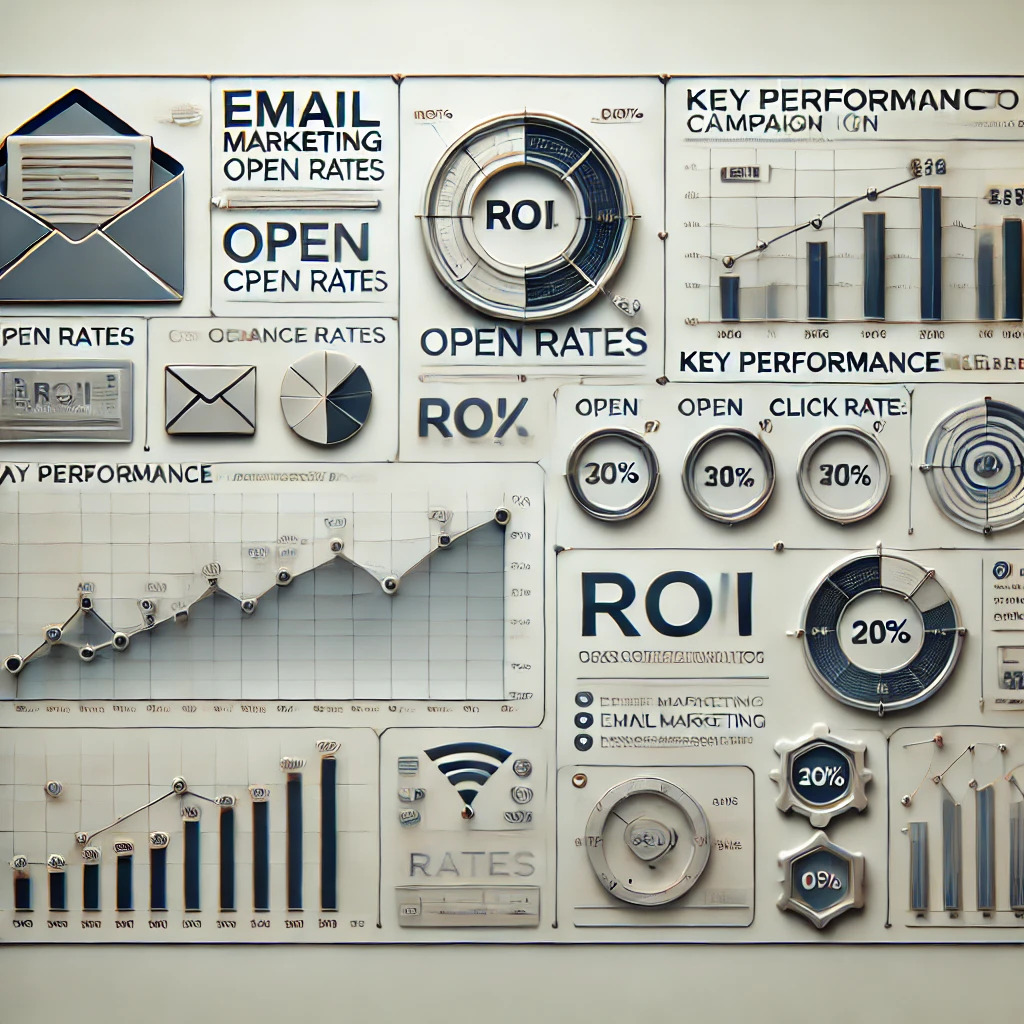
Understanding the return on investment (ROI) in email marketing is essential for businesses striving to maximize their digital campaigns. ROI serves as a key indicator of how effectively your resources are being utilized to drive revenue, making it a cornerstone for evaluating your email marketing tactics. By identifying what works and what doesn’t, businesses can refine their strategies to achieve higher engagement, stronger customer relationships, and increased profitability.
Understanding ROI in Email Marketing: Why It Matters

Return on investment (ROI) is one of the most critical metrics in digital marketing, especially when evaluating the success of your email marketing tactics. ROI helps you understand how effectively your email campaigns are generating revenue relative to the costs involved. It’s not just a measure of profitability but also a clear indicator of the impact and efficiency of your strategies.
Defining ROI in Email Marketing
In the context of email marketing, ROI represents the revenue gained from your campaigns compared to the money spent. The formula is simple:
ROI = (Revenue – Investment) / Investment × 100.
For example, if your campaign costs $500 and generates $5,000 in revenue, your ROI is 900%. This straightforward calculation highlights why focusing on effective email marketing tactics can yield exponential results.
The Importance of Measuring ROI
Measuring ROI allows you to identify what’s working and what isn’t. This insight helps refine your email marketing tactics, ensuring that your resources are directed toward strategies that maximize returns. Campaigns with a high ROI typically include personalized content, targeted messaging, and compelling calls-to-action (CTAs), all of which drive engagement and conversions.
Failing to monitor ROI often results in wasted efforts. For instance, investing in poorly segmented email lists or untested content can lead to low engagement and minimal returns. Regularly analyzing ROI ensures that your campaigns align with your overall business goals, allowing for better allocation of time and money.
Common Pitfalls That Reduce ROI
Despite its potential, many marketers struggle to achieve high ROI due to avoidable mistakes. One major issue is neglecting audience segmentation. Without tailoring your message to specific demographics or customer needs, even the best email marketing tactics can fall flat. Similarly, skipping A/B testing prevents you from optimizing key elements like subject lines or CTAs, reducing the effectiveness of your campaigns.
Another common error is overloading emails with promotional content without offering value. Subscribers expect informative or engaging material, so a lack of balance can lead to high unsubscribe rates. Monitoring metrics like open rates and click-through rates helps you address these issues and improve your overall strategy.
By understanding ROI and avoiding these pitfalls, you can ensure that your email marketing tactics are consistently driving meaningful results for your business.
Crafting Irresistible Subject Lines and Email Copy

When it comes to implementing effective email marketing tactics, crafting compelling subject lines and email copy is essential. These two elements are the first things your audience interacts with, making them critical in capturing attention and driving engagement.
The Importance of Subject Lines in Driving Open Rates
Subject lines act as the gateway to your emails. If your subject line fails to grab attention, the rest of your email marketing tactics won’t even get a chance to work. Research shows that 47% of recipients decide to open an email based solely on the subject line. This highlights the importance of making subject lines clear, concise, and intriguing.
Effective subject lines often create curiosity or promise value. For example, instead of writing “Our Monthly Newsletter,” opt for something like “5 Exclusive Deals You Can’t Miss This Month.” By aligning your subject line with the interests of your audience, you can significantly increase open rates.
Creating Engaging and Relevant Email Content
Once the subject line has done its job, your email content must deliver on its promise. Using strong email marketing tactics ensures your content is engaging, relevant, and actionable. Start by addressing the recipient by name—this simple personalization technique can boost engagement rates.
Focus on creating concise yet impactful content. Emails should provide value, whether it’s in the form of exclusive offers, helpful tips, or insightful information. Avoid overwhelming readers with long paragraphs; instead, use bullet points, subheadings, and clear CTAs to guide them.
Personalization Techniques to Connect with Your Audience
Personalization is one of the most effective email marketing tactics for connecting with your audience. This goes beyond using the recipient’s name; it involves tailoring the content to their preferences, behavior, and past interactions. For instance, segment your email list to target specific groups based on purchase history or browsing habits.
Dynamic content is another powerful tool for personalization. Using variables like location, product preferences, or user behavior allows you to create hyper-relevant emails that resonate with your audience. When recipients feel understood, they’re more likely to engage with your content and take the desired action.
Incorporating these email marketing tactics into your strategy will help you craft subject lines and content that not only capture attention but also build stronger relationships with your audience. Ultimately, this will boost your open rates, click-through rates, and overall ROI.
Segmentation and Targeting: Reaching the Right Audience

One of the most effective email marketing tactics is segmentation and targeting, a strategy that ensures your messages reach the right audience at the right time. By dividing your email list into specific groups based on shared characteristics, you can craft personalized campaigns that resonate with your subscribers, driving engagement and boosting ROI.
The Benefits of Segmenting Your Email List
Segmentation allows you to move beyond a one-size-fits-all approach to email marketing. Instead of sending generic messages to your entire audience, you can tailor content to meet the unique needs of specific segments. This increases the relevance of your emails, leading to higher open rates, click-through rates, and conversions.
For example, a clothing retailer can segment its list based on gender, purchase history, or geographic location. A campaign targeting customers in colder climates might promote winter apparel, while another segment could receive updates on summer sales. These targeted messages are a direct result of effective email marketing tactics.
Examples of Effective Segmentation Strategies
Segmentation can take many forms, depending on your business and audience. Here are a few proven strategies to implement:
- Demographic Segmentation: Group subscribers by age, gender, income, or other demographic factors.
- Behavioral Segmentation: Target users based on actions like past purchases, website activity, or engagement with previous emails.
- Engagement-Based Segmentation: Separate active subscribers from inactive ones and create re-engagement campaigns for the latter.
- Location-Based Segmentation: Tailor content based on time zones, regional preferences, or local events.
Each of these email marketing tactics allows you to refine your messaging and address the specific needs of each group, leading to better results.
How Targeting Improves Engagement and ROI
When segmentation is combined with targeted messaging, the results can be transformative. Instead of bombarding your entire list with irrelevant offers, targeting enables you to send content that aligns with individual preferences and behaviors. This approach fosters trust and loyalty, as subscribers feel understood and valued.
For instance, a customer who recently purchased a laptop might appreciate an email offering accessories like cases or external drives. Such precise targeting, an essential part of modern email marketing tactics, not only improves engagement but also increases the likelihood of repeat purchases.
Incorporating segmentation and targeting into your email campaigns is a surefire way to enhance their effectiveness. These email marketing tactics ensure your messages are relevant, personalized, and impactful, ultimately driving higher ROI.
A/B Testing: Optimizing Campaign Performance

A/B testing is one of the most powerful email marketing tactics for optimizing campaign performance. It allows marketers to compare two versions of an email to determine which one performs better with their audience. By making data-driven decisions through A/B testing, you can continuously improve your campaigns and maximize ROI.
What Is A/B Testing and Why Is It Vital?
A/B testing, also known as split testing, involves sending two slightly different versions of an email to a small segment of your audience. The version that performs better, based on metrics like open rate or click-through rate, is then sent to the rest of the list. This process helps eliminate guesswork and ensures that your email campaigns are driven by data rather than assumptions.
For example, if you’re unsure whether a formal or casual tone resonates better with your audience, you can test both options. This helps refine your email marketing tactics and ensures you’re always using strategies that work.
Elements to Test in Your Emails
A/B testing can be applied to various components of your emails to identify areas for improvement. Some key elements to test include:
- Subject Lines: Experiment with different wordings, lengths, or tones to see which drives higher open rates.
- Call-to-Action (CTA): Test the placement, wording, or design of your CTAs to determine which generates more clicks.
- Email Design: Compare layouts, color schemes, or font styles to find the most visually appealing option.
- Personalization: Test whether adding the recipient’s name or tailoring content to their preferences increases engagement.
- Send Times: Experiment with different days and times to identify when your audience is most likely to engage.
Each of these elements can provide insights into how to fine-tune your email marketing tactics for maximum effectiveness.
Analyzing and Applying Test Results
After conducting A/B tests, it’s crucial to analyze the results carefully. Focus on the metrics that matter most for your goals, whether it’s open rate, click-through rate, or conversions. Use these insights to inform future campaigns, ensuring that each email you send is optimized for success.
For instance, if a specific subject line significantly boosts open rates, consider using similar phrasing in future campaigns. This iterative approach is what makes A/B testing such a valuable component of effective email marketing tactics.
By integrating A/B testing into your strategy, you can continuously refine your campaigns, ensuring they resonate with your audience and deliver the best possible results.
Analyzing Metrics and Refining Your Strategy

One of the most essential email marketing tactics for achieving consistent success is analyzing campaign metrics and refining your strategy based on the data. By monitoring key performance indicators (KPIs), you can gain valuable insights into what’s working, identify areas for improvement, and optimize future campaigns for better results.
Key Metrics to Track
To effectively analyze your email campaigns, it’s important to focus on metrics that reflect audience engagement and campaign success:
- Open Rate: This metric shows the percentage of recipients who opened your email. A low open rate may indicate that your subject line isn’t compelling enough or that your emails are not being delivered to the right audience.
- Click-Through Rate (CTR): CTR measures the percentage of recipients who clicked on a link within your email. This is a direct indicator of how engaging and relevant your content is to the audience.
- Conversion Rate: This metric tracks how many recipients completed a desired action, such as making a purchase or signing up for a webinar, after clicking through your email. It’s a critical measure of ROI for your email marketing tactics.
- Bounce Rate: High bounce rates suggest issues with your email list, such as outdated or incorrect email addresses. Regularly cleaning your list is an important part of maintaining effective email campaigns.
- Unsubscribe Rate: This metric indicates the number of recipients opting out of your emails. High unsubscribe rates may signal that your content is not meeting audience expectations or that your frequency is too high.
Interpreting Metrics for Actionable Insights
Once you’ve gathered data, the next step is interpreting it to refine your email marketing tactics. For instance, if your open rate is low, consider revisiting your subject lines or segmenting your audience more effectively. If your CTR is below average, test different calls-to-action (CTAs) or improve the visual layout of your emails.
Refining Your Strategy Based on Data
Data analysis isn’t just about identifying problems; it’s about using insights to refine your strategy. Regularly A/B testing various elements of your campaigns, such as subject lines, CTAs, and content, can help you understand what resonates most with your audience. Incorporating personalization and segmentation based on these insights ensures that your emails remain relevant and impactful.
By prioritizing the analysis of metrics and continuously refining your email marketing tactics, you can create campaigns that consistently deliver higher engagement and stronger ROI.
Conclusion
For businesses looking to optimize their campaigns further, understanding advanced email marketing strategies is crucial. Resources like HubSpot’s Ultimate Guide to Email Marketing provide in-depth insights into segmentation, automation, and content creation, all of which are pivotal for improving your ROI. By combining these proven techniques with the tactics mentioned here, you can create high-performing campaigns that truly resonate with your audience.
Analyzing and optimizing ROI is not just a measure of campaign success but a roadmap to refining your email marketing tactics for long-term results. By focusing on metrics, avoiding common pitfalls, and implementing strategies like segmentation, A/B testing, and compelling content creation, you can ensure your campaigns resonate with your audience and deliver meaningful outcomes. Ultimately, understanding ROI empowers businesses to leverage email marketing as a powerful tool for sustained growth and profitability.
For more details or to discuss your specific Email marketing, visit our Email Marketing page.

